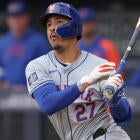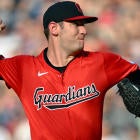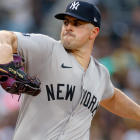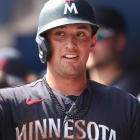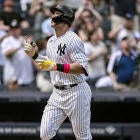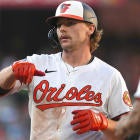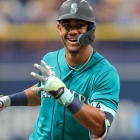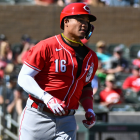Al Melchior's breakouts | Scott
White's breakouts
Not all breakouts are alike.
The 12 players below are at different stages of their careers and have varied levels of service time. Garrett Jones and Rick Porcello have spent a combined 11 seasons in the major leagues. Avisail Garcia and Adam Eaton have played a total of 183 games between the two of them.
But there's something there for each of these players -- a new team, a season free from injury, a better lineup or defense -- that has them set up as breakout candidates. Some of these players may even spill over into "sleeper" territory. Sleepers (at least as I loosely define them) carry a good deal of risk, but are going late enough in drafts where the downside is minimized. Breakouts have a better amount of statistical backing, with enough optimism based on situation and potential to make them worth a fairly confident gamble a round or two ahead of where their ADP would indicate.
Note: The numbers in parentheses reflect average draft position on CBSSports.com, assuming a 12-team league.
Jedd Gyorko, 2B, Padres (Roto: Rd. 8, H2H: Rd. 8)
As a 24-year-old rookie in 2013, Gyorko hit .249 with 23 home runs, 26 doubles, and a stolen base over 125 games. Gyorko battled a groin injury for a significant portion of the season, and hit in a lineup that was decimated by injury (Carlos Quentin played in 82 games, Yonder Alonso played in 97) and suspension (Yasmani Grandal played in 28 games and served a Biogenesis penalty; Everth Cabrera served a 50-game suspension, as well). But Gyorko has an outstanding minor league track record -- a career .321 average and .916 OPS, with 55 total home runs over his 2011 and 2012 seasons.
Just for comparison's sake, take a look at two of the top second basemen in Fantasy: Robinson Cano didn't hit the 20-homer mark until his fifth season. Dustin Pedroia did it in his sixth. Gyorko not only hit more homers his rookie year, but his minor league batting average was higher and more consistent (he never hit below .300 in any of his minor league campaigns) than Cano and Pedroia. Last year, Gyorko had the second-most home runs among second basemen, and could easily lead the position this season. He will see gains in batting average, should see a jump in power with a fully healthy season, and could benefit from having a stable lineup around him.
Rick Porcello, SP, Tigers (Roto: Rd. 25, H2H: Rd. 20)
Porcello has made 152 appearances in the majors, with 868 2/3 innings pitched. He's been a known quantity of sorts for a while -- he has a career 4.51 ERA and 1.39 WHIP. So he's not your typical breakout pick. But the Tigers did some major re-tooling this offseason, moving Miguel Cabrera back to first base and trading for second baseman Ian Kinsler. They also traded for Jose Iglesias -- who has a tremendous glove -- last season, and are expected to start Nick Castellanos at third. That defense is a marked improvement from previous seasons, and it should benefit Porcello, who had the second-highest groundball percentage in the majors last year (55.5 percent).
Additionally, Porcello -- who, at 25, is younger than Stephen Strasburg, Jarrod Parker, and Clayton Kershaw -- saw a big leap in K/9 last season, going from 5.5 in 2012 to a career-high 7.2 in 2013; his strikeout rate has gone up every year since 2010. So, we have a groundball pitcher with a major upgrade defensively and a continued increase in strikeouts. Porcello could end up being a top 30 pitcher in 2014, if everything clicks.
Yan Gomes, C, Indians (Roto: Rd. 15, H2H: Rd. 23)
Very quietly last season, Gomes hit .294 with 11 home runs and 18 doubles over 293 at-bats. The 26-year-old enters 2014 as Cleveland's primary catcher, with Carlos Santana moving to third, first, or DH. Gomes had an interesting road to he majors, with a fluctuating batting average (it all evened out to .287 over five seasons) and two campaigns with 13 home runs, despite getting over 300 at-bats just once.
The power looks legitimate, but the batting average could be anywhere from .240 to .290. Still, Gomes is going to see something close to everyday at-bats (450-ish), and is a solid candidate to surpass the 20-home run mark. His average should be good enough to elevate him into the top 12 of catchers.
Tony Cingrani, SP, Reds (Roto: Rd. 13, H2H: Rd. 10)
Cingrani had a 1.65 ERA and 0.95 WHIP over 228 2/3 minor league innings. He struck out 301 batters over that span, and started all but one of his 45 appearances. Over 109 2/3 major league innings, the 24-year-old has a 2.87 ERA, with a 1.10 WHIP and 129 strikeouts. But Cingrani has made eight appearances as a reliever in his career, with a 3.65 ERA over those 12 1/3 innings. As a major league starter, Cingrani has a 2.77 ERA and 1.04 WHIP. And that includes a stretch-out start in July 2013, as well as starts that were spaced out due to need -- and just general getting-to-know-the-game kinks to work out.
With the departure of Bronson Arroyo (to Arizona), Cingrani has a spot in the rotation all to himself, and can better prepare as a starter for the entire season. He pitched 151 innings in 2012 and 136 in 2013, so while he may not be a sure thing for 200 innings, he's built up enough stamina in his arm to keep that as a very real possibility. There's a very real chance Cingrani finishes the season with a sub-3.00 ERA, sub-1.18 WHIP, and over a strikeout per inning. His upside is Strasburg, and it would probably take an injury to see the wheels totally come off.
Garrett Jones, 1B/OF, Marlins (Roto: Rd. 30, H2H: Rd. N/A)
I'm a bit of a sucker for the player who has shown flashes of power in short stints, has gotten 500 at-bats once (or never at all), put up great minor league numbers (to demonstrate, at least partially, what the player can do with everyday at-bats), and is entering a new situation where he will likely play one position, instead of bouncing around between a few.
Jones is one of those players.
He's gotten 500 at-bats just once (in 2010), when he hit .247 with 21 home runs and 34 doubles. Jones has hit 20-plus home runs three times in the past five years, despite averaging just 441 at-bats. He's also never had a position to truly call his own, moving back and forth between first base (339 career games) and right field (276 career games). But after signing with the Marlins this offseason, Jones looks to have settled in at first base. And early indications are that he will get a crack at 500 at-bats. He can hit 25-plus home runs and 35-plus doubles if given a full-time job, and while he can't be relied on for average, there's potential there for .275 (although .250 is a better target). While first base is deep this season, Jones will carry his outfield eligibility with him in most leagues.
He's probably not going to crack shallower mixed leagues, but those in deeper formats could get a surprising breakout performance from Jones with very little investment.
Avisail Garcia, OF, White Sox (Roto: Rd. 23, H2H: Rd. N/A)
A great deal has been made of the similarities between Garcia and Miguel Cabrera. Both are 6-foot-4, 240-pound Venezuelans. They both started their careers at age 17. And both had a similar minor league track record -- good average, decent power and some speed. What Garcia lacked in power (relative to Cabrera), he made up for with speed; from 2010 to 2012, Garcia hit double digits in home runs twice, and stole 14 or more bases in all three seasons. Every year from 2009 to 2013, his OPS went up., and his average went up to a new level in 2012 (.299) and 2013 (.379 over 198 at-bats).
In 42 post-trade games with the White Sox, Garcia hit .304 with five home runs, three steals, and 21 RBI. Thanks to a timely call-up in 2012, Garcia already has 23 postseason at-bats, including three World Series appearances -- he hit .263 in 12 postseason games as a 21-year-old, suggesting he has the mental makeup to get through his first full season in the majors. Garcia isn't going to be a Head-to-Head darling -- he doesn't walk a ton and his doubles totals are relatively low -- but he should make up for those shortcomings in other areas. Mix a friendlier home stadium in, and Garcia could be one of Fantasy's biggest surprises in 2014.
Nolan Arenado, 3B, Rockies (Roto: Rd. 20, H2H: Rd. 22)
I'm not sure why there aren't more Fantasy owners embracing Arenado. He won the Gold Glove last season and finished seventh in Rookie of the Year balloting. Over 486 at-bats, Arenado hit .267 with 10 home runs and 29 doubles. He was a perennial top prospect through the minors, carrying a .299 average over five seasons. Each year from 2010 to 2012, he hit double digit home runs and had 30-plus doubles. And he'll be playing the 2014 season with a healthy Carlos Gonzalez and Troy Tulowitzki in the lineup, while playing half of his games in Colorado.
Arenado, who will be 23 in April, has plenty on which to build. His average could go up to the .280 range, he could double his home run output, and his owners will probably get about five steals thrown in, as well. Head-to-Head owners should also be treated to about 35-40 doubles. Arenado's glove will keep him in the lineup, even through figurative slumps, but there's a very good chance that scenario may never arise. With third base supposedly a shallow position this season (I don't buy it, but I'll allow the argument), Arenado makes for a stellar late-round addition in any format.
Leonys Martin, OF, Rangers (Roto: Rd. 9, H2H: Rd. 18)
There was a brief period of joy for Martin speculators this winter, as he was the leading candidate to bat leadoff for the Rangers -- a dangerous lineup that had just added Prince Fielder to the mix. But then Texas signed Shin-Soo Choo, sending Martin tumbling down to the ninth spot. I'm not jumping off this ship just because he's going to start the season in the ninth spot (my guess is that he's higher in the lineup by May). Martin finished 2013 with a .260 average, eight home runs, and 36 steals over 457 at-bats. And this was as he played through an August ankle injury and June wrist issue.
Martin's 2013 campaign followed a two-year minor league stint in which he hit .323 with an .891 OPS. In 2012, Martin hit .359, with 12 home runs and 10 stolen bases over just 231 minor league at-bats. The 26-year-old should be more comfortable in 2014, with every day at-bats and a position to call his own. His batting average should see some gains, and his power should continue to develop. Add it all up, and a .290, 20-homer, 40-steal season isn't out of the question for Martin.
Evan Gattis, C, Braves (Roto: Rd. 7, H2H: Rd. 10)
Gattis played in 105 games last season -- 42 at catcher, 48 in left field, four at first base, and two at DH. He still managed 21 home runs and 21 doubles (with a .243 average). You often hear players talk about how much better it is to play just one position; there's a better sense of preparation, it puts the mind at ease, and allows batters to focus on fewer tasks.
Gattis is going to be the team's primary catcher in 2014, with the occasional stint at first base and some at-bats at DH. But the constant of playing just one position should be a benefit to Gattis' batting average, allowing him to get into a groove at the plate. The power is legitimate -- he could eclipse 30 home runs by the end of August -- but Gattis has plenty of ground to make up in batting average. Over four minor league seasons, he hit .308, with his average dipping below .300 just once in four campaigns. Gattis had a .255 BABIP in 2013, which is far below the league average mark, suggesting that some bad luck played a role in his low average. He struck out a decent amount and didn't walk much, but if Gattis can get his BABIP up to his minor league levels -- which is wholly possible -- he could finish 2014 with an average closer to .280 than .240. Throw in the power and the doubles, and Gattis has a legitimate shot at being a top five catcher when the dust settles on the season.
Andrew Cashner, SP, Padres (Roto: Rd. 15, H2H: Rd. 10)
The Padres handled Cashner brilliantly last season -- starting him out in the bullpen (after a hunting incident delayed his spring training), and eventually stretching him out, allowing Cashner to pitch into late September in his first full season as a starter.
The result was a 3.09 ERA and 1.13 WHIP, with 128 strikeouts in 175 innings.
While the K/9 rate was a little disappointing, this might have been part of an effort to keep Cashner's pitch count down and get him deeper into games. Over his last seven starts, Cashner struck out 45 batters in 51 2/3 innings -- a rate more in line with what his minor league performances would have suggested (he also had a 1.22 ERA over those final seven starts). In fact, Cashner didn't strike out seven batters in a game until August 14. He would repeat that feat five more times over his final six starts. Cashner throws hard; if you just look at his strikeout rate, you wouldn't think that (much like Miami's Nate Eovaldi), but he was fourth in the majors last season in average fastball velocity (94.6 mph) among starters. And his velocity kept going up as the season wore on.
Heading into 2014, there's a good chance Cashner doesn't hold back early in the season and comes out throwing hard and going after strikeouts. His ratios should continue to hold, but a jump in K/9 would bring Cashner up a level or two in Fantasy.
Kole Calhoun, OF, Angels (Roto: Rd. 19, H2H: Rd. 21)
Speculation about Calhoun batting leadoff drove his value up, moving him from "sleeper" to "breakout." The 26-year-old hit .282 with eight home runs, seven doubles, and two steals over 195 at-bats last season. And this complemented his .354 average with 12 home runs, 10 steals, and 15 doubles in 59 games at Triple-A.
In fact, Calhoun had been stellar throughout his minor league career -- a .317 average over 353 games, with three seasons of double digit home runs and double digit steals. He had a .943 career OPS and only finished with an OBP below .400 just once. But he never made any top prospect lists and dodged a lot of minor league talk (while also contending with fellow Angels minor leaguer Kaleb Cowart as the player with the K/C initials that you might confuse with the other).
But here's why Calhoun has staying power -- a long line of Angels prospects had numbers inflated by the PCL, never producing much at the major league level. Mike Trout reversed that trend, and Calhoun followed suit, performing at a level that his prior numbers suggested. If you're counting on a renaissance from Josh Hamilton and Albert Pujols, Calhoun is an even bigger breakout candidate, hitting in front of a trio (including Trout) that boasts perennial MVP consideration and has over a dozen All-Star appearances between the three of them. Calhoun himself could flirt with a 15/15 season (maybe even 20/20 if things break the right way), but the runs he can score at the top of the lineup make him an even sweeter Fantasy target.
Adam Eaton, OF, White Sox (Roto: Rd. 19, H2H: Rd. 18)
Thanks to an elbow injury and ensuing setbacks, Eaton never really had a shot at breaking out in 2013. He finished the season with a .252 average, three home runs, and five steals in 250 at-bats.
This is way off from what Eaton is capable of doing. Before his 2013 rehab assignment, Eaton had never hit below .318 in three minor league seasons. He had stolen 20-plus bases in each of the three campaigns, with gains each year (reaching a crescendo in 2012 with 44 steals). He had 47 doubles in 2012, and hit at least seven home runs in each of those seasons.
Eaton is a hitter. He may not have the power upside of Jacoby Ellsbury -- and he may be 10-20 steals below Ellsbury's projected totals -- but there are similarities. Eaton can hit .300, with six home runs and 50 steals (this is his ceiling, not a projection) in 2014. And you won't have to use a first-round pick to get those numbers (maybe not even a 15th round pick, if things continue as they have so far this preseason). There's always downside -- his elbow injury may get aggravated and require Tommy John -- but all indications are that he's healed and it shouldn't be a hindrance. Drafting Eaton requires a certain amount of faith, but it's an easily-arrived faith, as he has 1,210 minor league at-bats that hint at what he's capable of doing in a full, healthy major league campaign.
Stay in touch with the most passionate Fantasy staff in the business by following us on Twitter @CBSFantasyBB or Nando at @NandoCBS .







